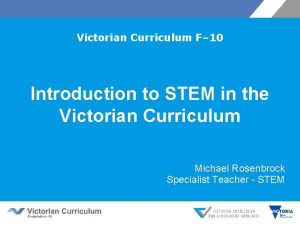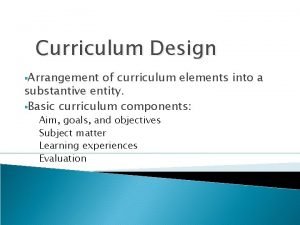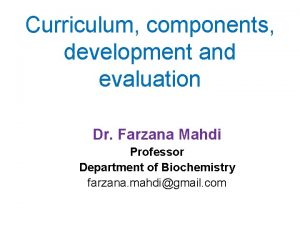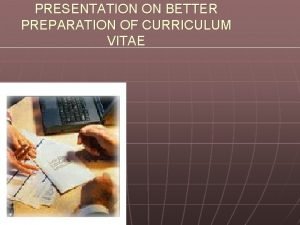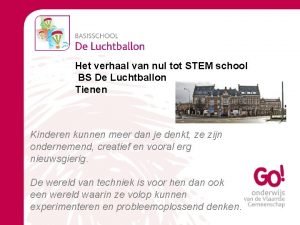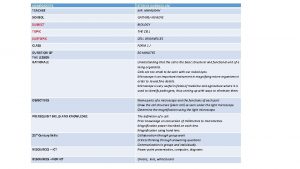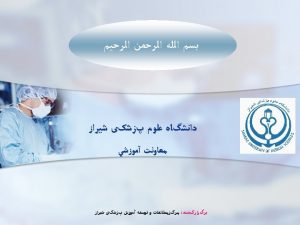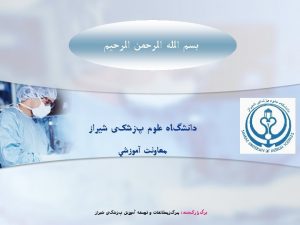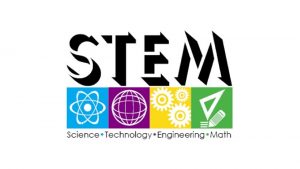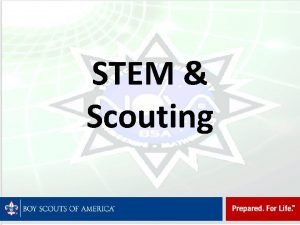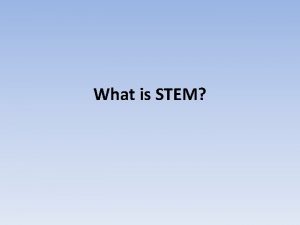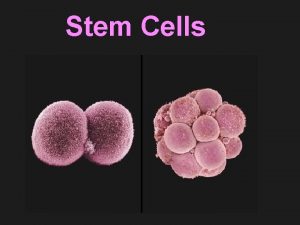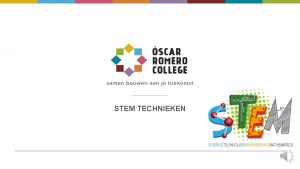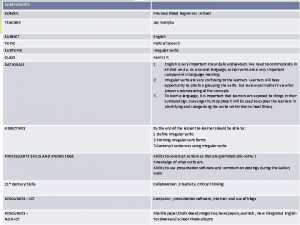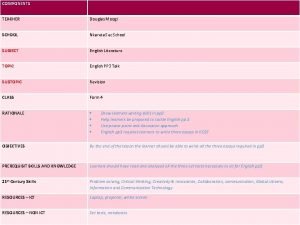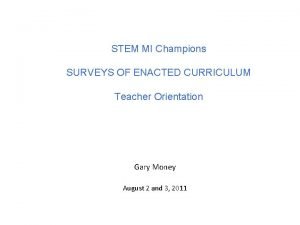COMPONENTS TEACHER STEM IN CURRICULUM MR MWAURAH SCHOOL

























- Slides: 25

COMPONENTS TEACHER STEM IN CURRICULUM MR. MWAURAH SCHOOL GATHIRU-INI BOYS SUBJECT BIOLOGY TOPIC THE CELL SUBTOPIC CELL ORGANELLES CLASS FORM 1 J DURATION OF THE LESSON RATIONALE 80 MINUTES OBJECTIVES PREREQUISIT SKILLS AND KNOWLEDGE 21 st Century Skills RESOURCES – ICT RESOURCES –NON ICT Understanding that the cell is the basic structural and functional unit of a living organisms. Cells are too small to be seen with our naked eyes. Microscope is an important instrument in magnifying micro-organisms in order to reveal fine details. Microscope is very useful in fields of medicine and agriculture where it is used to identify pathogens, thus coming up with ways to eliminate them. Name parts of a microscope and the functions of each part Draw the cell structure (plant cell) as seen under the light microscope. Determine the magnification using the light microscope. The definition of a cell. Prior knowledge on conversion of millimetres to micrometres. Magnification power inscribed on each lens. Magnification using hand lens. Collaboration through group work Critical thinking through answering questions Communication in groups and individually. Power point presentation, computer, diagrams Onions, lens, white board

THE CELL Where does life begin? Where do Human Beings come from? Can human body be split into smaller independent parts ? Can we see a sperm cell with our eyes? Definition A cell is the basic unit of an organism. It is the basic structural and functional unit of a living organism.

• Unicellular and multicellular organisms. • All living organisms are made up of cells. • Some organisms are made up of one cell and are said to be unicellular. e. g. amoeba (below as seen under microscope) • Other organisms are made of many cells and are said to be multicellular e. g human Beings, maize, cow • Cells are too small to be seen with the our naked eyes. • Cells can only be seen with the aid of a microscope.

Microscope Its an instrument used to magnify small objects in order to reveal fine details. • There are two types of microscopes; a) Light microscope- uses light to illuminate specimen b) Electron microscope- uses a beam of electrons to illuminate specimen

The light microscope

Draw and label the parts of a microscope State the function of each part

functions of parts of a microscope Parts Eye piece Function(s) Has a lens which contributes to the magnification of the specimen under view. Coarse adjustment knob Moves the body tube up and down for long distances to bring the image into focus. Fine adjustment knob Moves the body tube through small distance to bring the image into sharp or fine focus. Body tube Holds the eye piece and the revolving nose piece. Holds and brings objective lenses into position. Enabling changing Revolving nose piece from one objective lens to the other. Objective lens Contributes to the magnification of the specimen.

Part function Arm/limb Supports the body tube and for handling the microscope. Stage Is the flat platform onto which the slide with the object is placed. Clips They hold the slide firmly onto the stage. Condenser Concentrates light onto the specimen. an aperture that regulates the amount of light passing through the condenser onto the specimen. Diaphragm Mirror Reflects light through the condenser onto the specimen. Hinge screw Fixes the arm to the base and allows for tilting of the arm. Base/stand Provides firm and steady support to the microscope.

How to use the microscope • Turn the low power objective lens until it clicks into position. • Open the diaphragm and look through the eye piece, ensure that enough light is passing through by adjusting the mirror. • A circular area is seen. This is known as the field of view. • Place the slide containing the specimen on the stage and clip it into position. • Make sure that the specimen is in the Centre of the field of view. • Using the coarse adjustment knob, bring the low power objective lens to the lowest point. Turn the knob gently until the image comes into focus. • Use the fine adjustment knob to bring the image into sharp focus. • For higher magnification use high power objective lens and move the fine adjustment knob upwards gently until the image comes into sharp focus.

PRACTICAL; preparation of temporary slides. • Cut a thin piece of epidermis from onion bulb. • Put it in beaker half full of distilled water, add 3 drops of iodine. Wait for 5 minutes. • Place thin epidermis on a glass slide, spread it and cover with a cover. • Observe the specimen under low and medium objective lens. • Draw and determine magnification

My diagram

Plant cell as seen under light microscope draw the plant cell

how to determine magnification • The magnifying power is usually inscribed on the lens. • To find out how many times a specimen is magnified, the magnifying power of the objective lens is multiplied by that of the eye piece lens. Magnification = eye piece lens x objective lens • If the eye piece magnification lens is x 10 and the objective lens is x 4, the total magnification is x 10 x x 4 = x 40 • Magnification has no units. • It should always have the multiplication sign. e. g. x 40

Complete the table below Eye piece Objective lens x 5 x 4 x 10 x 50 x 40 x 10 x 20 x 15 x 20 magnification x 100 x 400

Estimation of Cell Size.

Determine the size of one cell • Diameter of field of view = 10. 5 cm 1 cm = 10 mm 10. 5 cm= ? Cm 10. 5 x 10 =105 mm 1 mm = 1000 micrometres 105 mm = ? um 105 x 1000 = 105000 um one cell = = 105000 um 5 cells = 21000 um

Estimation of Cell Size. • Using the low power objective, a transparent ruler is placed on the stage of the microscope. • An estimation of the diameter of the field of view is made in millimeters. • This is converted into micrometers (1 mm=1000 u) • A prepared slide of onion epidermal cells is mounted. • The cells across the center of the field of view are counted from left and right and top to bottom. • The diameter of field of view is divided by the number of cells lying lengthwise to give an estimate of the length and width of each cell. Cell size = Diameter of field of view in micrometer Number of cells across the field of view

Complete the following 1. During a practical using microscope Peter observed the field of view of 3. 5 mm, they observed yeast cells across the same field of view and counted 8 cells. Calculate the size of each cell and give your answer in micrometers. 2. In a laboratory exercise a student observed a drop of pond water under a microscope saw and drew a spirogyra cells. If the magnification of the eye-piece was x 5 and that of the objective lens was x 100. a) what was the magnification of the spirogyra? b) If the field of view was 5 cm and 20 cells were counted, calculate the actual length of a spirogyra cell in micrometers.

Answer the following Questions 1. Why was it necessary to use thin sections of epidermis? 2. Why was it necessary to put the specimen in water? 3. Why was iodine solution added to the specimen? 4. Why was it necessary to use sharp scalpel?

Cell Structure as Seen under the Light Microscope • The structures within the cell are called Organelles. • Organelles perform specific functions within the cell.

Plant cell as seen under light microscope

Animal cell as seen under light microscope

Electron microscope

How the Electron microscope functions • Has high magnification of up to 500, 000 times. • Uses a beam of electrons to illuminate specimen. • The major disadvantage of the electron microscope is that it cannot be used to observe living cells as the specimen has to be place in a vacuum chamber. • It has high resolving power than the light microscope. N/B: Resolving power is the ability to see two close points as separate points.

Comparison between light microscope and electron microscope. Light microscope Electron microscope • Has a high magnification of up to 500, 000 times. • Has a high resolving power. • Uses a beam of electrons to illuminate the specimen. • Cannot be used to observe living cells. • Has low magnifying power. • Has low resolving power. • Uses light to illuminate the specimen. • Can be used to observe living cells.
 Stem victorian curriculum
Stem victorian curriculum Erf requirements for teacher 3 2020
Erf requirements for teacher 3 2020 Hello good afternoon teacher
Hello good afternoon teacher Outcome based assessment in ecd
Outcome based assessment in ecd Advantages and disadvantages of pedagogical analysis
Advantages and disadvantages of pedagogical analysis The arrangement of the element of curriculum is known as?
The arrangement of the element of curriculum is known as? Components of curriculum
Components of curriculum Prescriptive curriculum
Prescriptive curriculum Aim and objectives of curriculum
Aim and objectives of curriculum Stages of curriculum development
Stages of curriculum development Components of a curriculum vitae
Components of a curriculum vitae T-stem early college high school
T-stem early college high school Stem school label
Stem school label Stem activiteiten lagere school
Stem activiteiten lagere school Xxxx with teacher
Xxxx with teacher Viikki teacher training school
Viikki teacher training school Grand prairie isd employment
Grand prairie isd employment School based teacher support system
School based teacher support system Mrs elliott a teacher at durham school of the arts
Mrs elliott a teacher at durham school of the arts After (taking) a bath, let’s go to the campus.
After (taking) a bath, let’s go to the campus. Ms lawson a primary school teacher
Ms lawson a primary school teacher Where did rizal start his formal schooling?
Where did rizal start his formal schooling? Viikki teacher training school
Viikki teacher training school What year was st patrick born
What year was st patrick born Windermere high school guidance counselors
Windermere high school guidance counselors Main defects of existing curriculum
Main defects of existing curriculum
